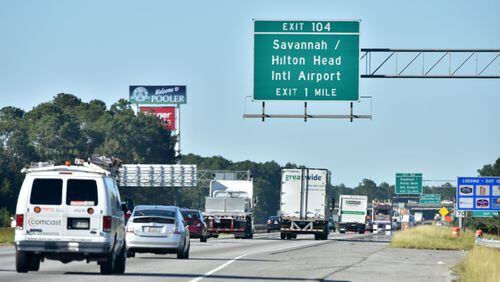Tens of thousands of evacuees returned home to coastal Georgia on Monday, anxious to see the damage left behind by Hurricane Matthew.
St. Simons Island was set to admit residents at noon Tuesday, becoming the last of the state’s major barrier islands to reopen.
Locals had been fuming that they were being kept away days after Matthew struck.
“I just want to be in my house,” said Jerry Davidson, an Atlanta native who has lived on St. Simons Island for two decades.
State emergency officials have lifted the evacuation for Bryan, Camden, Chatham, Glynn, Liberty and McIntosh counties although they warned that residents should be wary of downed trees and power lines.
On I-16, eastbound traffic was heavy as residents made their way home. Four Georgians died in the storm, which was a Category 2 hurricane when it battered the state’s shoreline early Saturday.
Tybee Island, which was particularly hard hit, has reopened to locals who could present IDs, although the mayor warned power remained off and hazards remained. Glynn County officials said residents would also need identification to return home Tuesday.
More than 100,000 people remain without power in areas near Georgia’s shoreline. On St. Simons Island, the power outage largely disabled the island’s sewer system, creating “a potential severe public health issue,” county spokeswoman Kathryn Downs said.
Davidson hasn’t been to his St. Simons home since before Matthew struck early Saturday. He understands that storm recovery efforts will be faster without extra people around. But as a former contractor, he said he could be using his generator and chain saws to help with the cleanup efforts. And he faulted Glynn County for not communicating more with stranded residents.
“They’re’ not keeping us really updated,” said Davidson, who took a single change of clothes when he left, thinking he would return the following day.
“We feel like we’re in the dark.”
In Savannah, residents were streaming back into the city on Monday. The common refrain: It could’ve been worse.
The damage across Chatham County will invariably reach into the tens, if not hundreds of millions of dollars. It was too soon for local officials to tally the destruction wrought by winds that hit 100 mph on Tybee Island and the surging waters that inundated miles of roads, neighborhoods, backyards and basements county-wide.
“We had all the wind and rain and the power knocked-out and this tree that ended up on top of the roof,” said Gregory Smart as two men with a chainsaw and rake removed a massive oak limb from his brother’s home in the Runaway Point community east of downtown Savannah. “There were some crazy winds. I was scared. But I think the city was very fortunate it wasn’t worse.”
A chorus of chainsaws serenaded evacuees allowed to return home Sunday afternoon. Utility crews lined the streets. Many straggled back early Monday morning, taking advantage of another’s night’s electricity in Claxton, Athens, Augusta or wherever they rode out the hurricane.
They returned to a city with large swaths without power and navigated intersections bereft of traffic lights with caution and courtesy. Most gas stations remained without fuel. The schools are closed all week. A curfew remains in effect countywide from 10 p.m. to 7 a.m.
But they were home. And Chatham, designated a federal disaster area by President Obama along with 29 other coastal counties, creaked back to life.
“We were lucky. We were very fortunate,” said Paul Kaluzne, 65, carting oak and pecan limbs and brush to the curb of his Yacht Club Estates home surrounded by the Wilmington River and Bradley Creek. He returned early Monday. “Cleanup is cleanup. Insurance will pick up the property damage and all. By Thursday, Savannah should be back and running as normal.”
The further east one ventured, the more damage was apparent. Savannah quickly set about raking up the oak leaves and moss that carpeted most downtown streets. A few boats plied the Savannah River early in the morning; the massive state port up the river from River Street will likely unload their first container ship Tuesday.
Henry’s diner, on Drayton Street, did great business with many Savannahians and recovery workers getting their first hot breakfast in days. The streets filled with caravans of Alabama Power, public safety and insurance company trucks heading to the county’s most-distressed neighborhoods.
Tybee Island, which bore the brunt of Matthew’s fury at the far eastern edge of the county, jutting into the Atlantic Ocean, remained power-less. City Hall advised residents not to flush toilets as the sewage treatment plant remained broken. An estimated 100 of the island’s 3,000 residents remained on Tybee for the storm; the rest trickled back late Sunday and Monday.
Larry and Kay Hess left Runaway Point last Thursday and headed north of Athens. They returned Sunday, taking back roads to avoid the Interstate 16 slog. Their home intact, they turned to the four rental properties one neighborhood over. Plenty of downed trees. A few leaky spots in roofs. Some shingles blown off.
“We got lucky. I expected worse. There was no water in any of my houses,” said Larry Hess, 74, his backyards backing into marsh. “Considering what could’ve happened it wasn’t bad.”
About the Author






